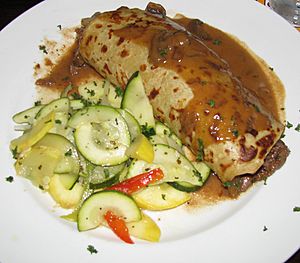Boxty facts for kids

Boxty, in a contemporary presentation served wrapped around beef and with courgettes and sauce
|
|
| Alternative names | Poundy, poundies |
|---|---|
| Type | Potato pancake |
| Place of origin | Ireland |
| Main ingredients | Potatoes, flour |
Boxty (Irish: bacstaí) is a yummy, traditional Irish potato pancake. It's a bit like a flat cake made from potatoes. This dish is very popular in certain parts of Ireland. These areas include the north midlands, north Connacht, and southern Ulster. You'll find it especially in counties like Leitrim, Mayo, Sligo, Donegal, Fermanagh, Longford, and Cavan.
There are many ways to make boxty. But all recipes use finely grated, raw potatoes. And they are always served fried! The most common way to make boxty uses grated raw potato and flour. Sometimes, people squeeze out extra starch and water from the grated potato. But you don't always have to do this.
The potato mixture is then fried on a griddle pan. It cooks for a few minutes on each side, just like a regular pancake. What makes boxty special is its smooth, fine texture. It's different from other fried potato dishes.
There's even an old Irish rhyme about it: "Boxty on the griddle; boxty on the pan. If you can't make boxty, you'll never get a man!"
Boxty has become more popular as people learn more about Irish cuisine. You can now find boxty on menus in restaurants outside its traditional areas. You can also buy boxty in shops and supermarkets. It comes either as a doughy "dumpling" or already cooked as pancakes.
Contents
How to Make Boxty
Boxty can be made in a few different ways. Each method creates a slightly different type of boxty.
Boxty Bread
When boxty is baked in a pan, it's sometimes called "Boxty bread."
- First, potatoes are grated over a cheesecloth. This helps drain out extra water.
- The starch from the potatoes will sink to the bottom of the potato liquid. This takes about 30 minutes.
- Next, the grated potatoes are mixed with mashed potatoes.
- When ready, the separated starch is mixed back into the potato mixture.
- Then, flour, salt, pepper, and melted butter or bacon fat are added.
- This mixture forms a "dough." It's kneaded and shaped into flat cakes.
- A cross is often scored (cut lightly) on top. This helps the cakes divide into farls when baked.
Pan-Fried Boxty Pancakes
Another popular way to make boxty is to pan-fry it like a griddle-cake.
- It starts the same way as boxty bread.
- But you add enough milk to make a runny batter.
- Some recipes also include egg yolk or baking soda.
- It's often best to let these boxty pancakes cool down. Then, you reheat them before serving.
- You can enjoy the finished pancakes with honey or butter. Or you can sprinkle them with sugar.
- They can also be filled with vegetables, meat, or cheese.
Boiled Boxty Dumplings
Boxty dough can also be boiled like dumplings.
- For this, you squeeze out extra moisture from the grated potato.
- Then, you mix it with mashed potatoes and flour.
- The dumplings are seasoned with salt.
- After boiling, they are sliced and pan-fried in butter.
- Modern versions might even include currants and raisins.
- Sometimes, they are served with cornflour sauce, similar to a steamed pudding.
Traditional Boxty Recipes
An old recipe from 1854 describes boxty. It was made by mixing potato with either flour or oatmeal. Animal fat or butter was added to form a cake. Back then, potato graters were often made from tin cans! With egg yolk, butter, and milk, the dough could be rolled about 5/8 of an inch thick. Then it was cooked on a griddle. Boxty was most often served with a bit of butter for tea. It was also a popular breakfast food.
Boxty and St. Brigid's Day
In Ireland, St. Brigid is a very important saint. She is known as the patron saint of dairy products. This means she is linked to milk, butter, cheese, and bacon. The traditions around St. Brigid might come from Ireland's ancient pagan history. This includes the pre-Christian "White Goddess" of Imbolc.
Boxty is often served for St Brigid's Day. This special day is on February 1st. Other traditional foods for this day include cross-shaped oat bread and Bride bannocks.
What Does "Boxty" Mean?
The word "Boxty" likely comes from the Irish language. It might come from the Irish phrase arán bocht tí. This means "poor house bread." Or it could come from bácús, which means "bakehouse."
See also
 In Spanish: Boxty para niños
In Spanish: Boxty para niños

